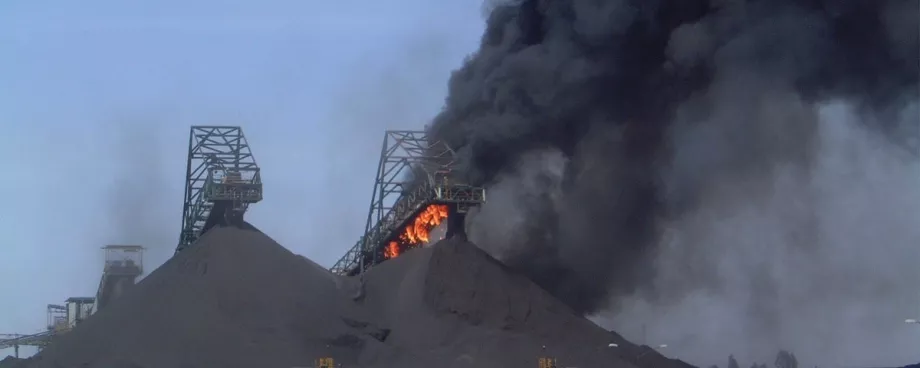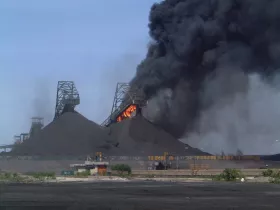
If a belt does not perform according to the manufacturer’s claims by wearing prematurely, ripping too easily or disintegrating due to excessive heat or because of oil penetration, the risk to life and limb is relatively small.
Yes, it can be very expensive but hardly life-threatening. But if a conveyor belt that is specified as being fire retardant catches fire but does not resist the fire the way that it should do then it will literally ‘convey’ the fire throughout the site. The consequences can be catastrophic.
Is Cost being put before Safety?
Due to the financial pressures on the cargo industry caused by the uncertain economic climate, more and more organisations are being forced to examine their day-to-day running costs and, almost inevitably, seek cost savings. The pressure to cut costs now seems to be influencing buying decisions concerning fire retardant conveyor belts.
Is price being put before safety? Or to put it another way, is the operator being lulled into a false sense of security by conveyor belt manufacturers and suppliers?
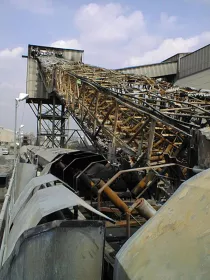
The discovery that a belt is not sufficiently fire retardant is only likely to be made when it is too late.Anecdotal as well as factual evidence gained from laboratory testing certainly indicates that even some of Europe’s biggest users of conveyor belts, including some major ports, may be using belts that are not as resistant to fire as they are supposed to be. In a growing number of instances, many sites that should be using fire resistant belting are operating with non-fire resistant belts simply because of ‘economy’.
At the same time, insurance companies are becoming increasingly concerned. According to at least one major insurer, claims for fires directly involving convey-or belts are costing an average of nearly USD 8 million per claim.
No Conveyor Belt is Fire proof
Fire retardency standards on specifications and test methods applied to conveyor belts are becoming increasingly stringent and can be very confusing. The first and most important thing to bear in mind is that conveyor belts cannot be totally fire proof. Using special additives and chemicals, the rubber used in the top and bottom covers that protect the carcass of the belt and the rubber skim between the fabric plies of the carcass can be engineered to resist fire but the complete structure of the belt cannot be made fire proof. The fabrics used in the carcass of the belt most commonly contain polyester and nylon, which have little or no resistance to fire. In other words, every belt will burn when it is exposed to a naked flame that has sufficient energy to ignite the belt. When choosing a fire retardant conveyor belt, deciding on the actual level of fire retardency needed for a specific application or environment is of crucial importance.
Environments with inflammable Dust and Gas
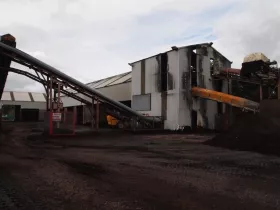
EN 12882 is the standard for safety requirements for conveyor belts for general-purpose use (not underground). The most basic electrical and flammability safety requirement is EN 12882 Category 1. For environments where coal dust, gas, fertilizer, grain or other potentially combustible materials are involved, it is essential that the conveyor belt cannot create static electricity that could ignite the atmosphere. Belts need to be able to allow static electricity to pass through the metal frame of the conveyor structure down to earth rather than allow static to build up. At Dunlop we decided some time ago that the safest approach was for all of our belts to be anti-static and conform to EN/ISO 284 international standards.
This means that they can all be used in ATEX 95 (94/9/EC Directive) classified zones. Some people mistakenly believe that all belts used in ATEX classified zones must be flame retardant but actually this is not the case.
ATEX regulations apply to industrial environments where there is a risk of explosion because dust or gas is present in the atmosphere. For those organizations that are buying conveyor belts for use in ATEX regulated areas it is very important to ask potential suppliers for a copy of a certificate provided by an appropriate independent testing authority such as Dekra Exam in Germany.
Interestingly, a belt that has good anti-static properties is also a good indication of the quality of the rubber used on the belt. All (black) rubber belts contain carbon black, which is an ingredient in the rubber compound needed to achieve good mechanical properties. The higher the quality of carbon black used to produce the rubber compound then the better anti-static properties it will have.
Above-ground and general Service Applications
Because fire safety is such an important issue there are numerous safety classifications and international standards for which there are many different tests used to measure the self-extinguishing properties of conveyor belts. Rubber belts reinforced by layers of textile fabrics (multi-ply) or steelcord reinforcement are the most commonly used type for transhipment and in general service applications. The basis of most tests for belting used in normal industrial applications is EN/ISO 340. This standard makes the distinction between fire resistance with covers (K) and fire resistance with and without covers (S).
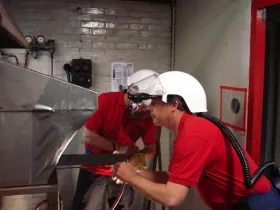
The relevance of “with and without covers” is that as belt covers wear during their operational life the amount of fire resistant rubber protecting the flammable carcass reduces. The best way to decide between ‘K’ and ‘S‘ grades is to consider the material being carried. For moderately abrasive materials such as grain, biomass for example then ‘K’ grade is usually perfectly adequate. This also applies to elevator belts. However, if the material is abrasive and tends to wear the top cover quite rapidly then the safest option is be to choose the ‘S‘ (Class 2B) grade.
In both ‘K’ and ‘S’ grades, the rubber skim that bonds the fabric layers of the carcass together should also be fire resistant. In the case of ‘S’ grade (fire resistant without covers), the rubber skim should be thicker than the skim used for ‘K’ grade. The easiest way to tell if a ‘K’ grade belt has the required thicker rubber skims is to obtain technical datasheets from the manufacturer for both ‘S’ grade and ‘K’ grades and compare the carcass thickness figures.
Another important reason why buyers should always request technical datasheets before placing an order is that they include information on the level of abrasion (wear) resistance. The ingredients used to create a fire resistant rubber compound generally have an adverse effect on its wear resistant properties. Consequently, fire resistant belts tend to wear faster and as the thickness of the rubber reduces so does the level of protection given to the inflammable carcass. To avoid premature wear, in the case of purely fire resistance belting, buyers should always demand an average abrasion resistance level of no more than150mm³.
Thankfully, at Dunlop our rubber compound technicians have proved that it is possible to have the best of both worlds by developing a fire resistant rubber that also has good resistance to abrasion. In fact our technicians have created a compound that has 50% better wear resistance than the DIN Y standard for abrasion resistant rubber. This means that the belt retains its resistance to fire for much longer and at the same time extends the operational lifetime by the same proportion. However, laboratory tests have revealed that this is very much an exception to the rule within the conveyor belt industry.










